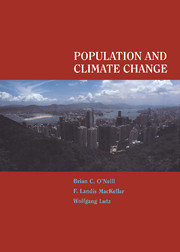Book contents
- Frontmatter
- Contents
- Foreword
- Preface
- Authors and Contributors
- Acknowledgments
- PART I
- 1 Climate Change
- 2 The Human Population
- 3 Population, Economic Development, and Environment
- PART II
- Appendix I Fertility and Mortality Assumptions for IIASA Population Projections
- Appendix II Household-level Economies of Scale in Energy Consumption
- Appendix III Population in Major Climate Change Assessment Models
- References
- Index
2 - The Human Population
Published online by Cambridge University Press: 23 December 2009
- Frontmatter
- Contents
- Foreword
- Preface
- Authors and Contributors
- Acknowledgments
- PART I
- 1 Climate Change
- 2 The Human Population
- 3 Population, Economic Development, and Environment
- PART II
- Appendix I Fertility and Mortality Assumptions for IIASA Population Projections
- Appendix II Household-level Economies of Scale in Energy Consumption
- Appendix III Population in Major Climate Change Assessment Models
- References
- Index
Summary
Dramatic changes in demographic patterns have taken place over the past several decades, particularly in less developed countries (LDCs). Mortality and, subsequently, fertility have fallen at rates much faster than rates of decline experienced in the industrialized countries. Unlike the more developed countries (MDCs), demographic transition from high to low fertility is not yet complete in many LDCs. In this chapter we summarize the current demographic situation and discuss factors behind the demographic transition in LDCs. This discussion provides background for the exploration of population–development–environment interactions taken up in Chapter 3 and in Part II of the book.
In addition, we discuss projected trends in population growth and aging over the 21st century based on the most recent projections of the International Institute for Applied Systems Analysis (IIASA). There appear to be three virtual certainties: world population will rise significantly from its present level of around 6 billion, although it may start to decline during the second half of the next century; its distribution will continue to tilt from MDCs to LDCs; and it will continue to age. Probabilistic projections indicate that global population is unlikely to double from its present size; on the other hand, a severalfold increase in the size of the population above age 60 is virtually assured. The 60+ age group, measured as a proportion of total population, will almost certainly double and will likely triple during the course of this century. The most important source of uncertainty in population projections is the future path of fertility, although the impacts of alternative trends in mortality and migration are significant as well.
- Type
- Chapter
- Information
- Population and Climate Change , pp. 39 - 80Publisher: Cambridge University PressPrint publication year: 2000



